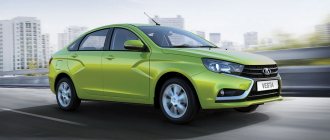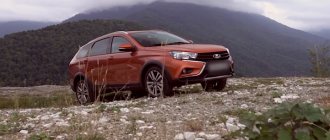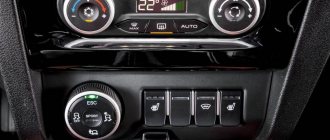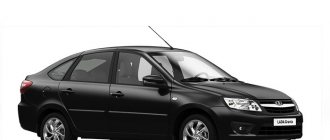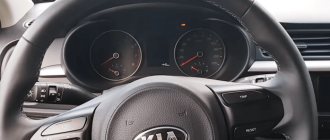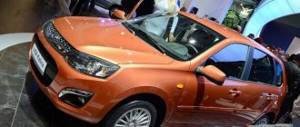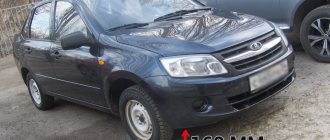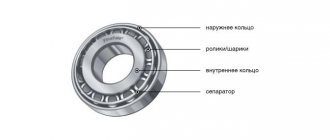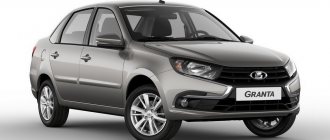Among budget sedans, the most popular in our country today are the creations of a popular South Korean manufacturer and an equally famous domestic brand. Both cars have many supporters and opponents. But what is actually better - Hyundai Solaris or Lada Vesta?
Lada Vesta 2020
The sedans are very similar in size and technical characteristics. They also have similar driving characteristics. The Russian car has a unique and memorable appearance, although the Korean is quite recognizable. If the first car is usually praised, the second one is often criticized and not recommended for purchase. But is AvtoVAZ’s creation so bad?
Comparison of technical characteristics
The cars have similar sizes and technical characteristics. Dimensions of Hyundai Solaris (length/width/height) are 4370/1700/1470 mm, and Lada Vesta – 4410/1764/1497 mm. Thus, the Russian is slightly longer, wider and taller than the Korean. True, this difference is almost invisible to the eye. But the same cannot be said about the ground clearance, since only a few millimeters can play a role here. For Solaris this figure is 160 mm, and for Vesta it is 178 mm. Therefore, the Lada is noticeably more passable than the Hyundai.
Both sedans have excellent technical equipment. Even in the most minimal configurations they have a sufficient number of systems responsible for comfort and safety. And the maximum versions amaze with their excellent equipment, which is in no way inferior to many more expensive cars. If initially many car owners were wary of the equipment of domestic cars, they have already managed to convince themselves of its sufficient reliability.
Exterior
It's no secret that the first thing that the vast majority of potential customers pay attention to is the external design of the car. As for the exterior, we can say with confidence that both candidates offer excellent shape, but still, most drivers and professionals are inclined to think that Vesta looks more attractive.
It immediately becomes clear that domestic specialists approached the matter with all diligence, and as a result, the overall impression of the design is more than good. “Solaris” has a lot of oriental style, while “Vesta” is still more related to European style traditions.
The use of the new X-Design concept in the appearance of Vesta did not escape motorists either. The table below contains the dimensions of both machines:
| Characteristic | "Vesta" | versus | "Solaris" |
| Length | 4410 mm | 4370 mm | |
| Width | 1764 mm | 1700 mm | |
| Height | 1497 mm | 1470 mm | |
| Clearance | 170 mm | 160 mm | |
| Base length | 2635 mm | 2570 mm |
As you can see from these data, Vesta is close in size to class C, in addition, the car looks larger, more solid and more representative than Solaris.
Engines and transmission
Solaris offers customers only two types of gasoline engines with the following indicators:
- volume 1.4 liters and power 100 hp;
- volume 1.6 liters with a power of 123 horsepower.
Vesta has a slightly larger selection of power units. This:
- 1.6 liters of volume with a power of 106 “horses”;
- 1.6 l and power 113 hp;
- volume 1.8 horsepower with a power of 122 “mares”.
In addition, the Russian sedan has a Sport version, equipped with a 1.8-liter engine with a power of 145 hp. Therefore, the domestic car not only offers a larger selection of power units, but is also noticeably more powerful and resourceful than the Korean. At the same time, both cars have good acceleration and excellent fuel economy.
By the way, Vesta also has a gas fuel version, which, however, has not become widespread among Russian motorists.
Sedans can be bought with both manual transmission and automatic transmission, which has recently been installed on the Lada. If the Korean has this unit reliable and tested, then how it will behave with the Russian is still unknown. Vesta can also be purchased with a robot, the quality of which many car owners have complained about. The manufacturer assures that today all the shortcomings of this unit have been eliminated, but despite this, some drivers still experience this problem. In addition, they claim that the Lada Vesta with a robotic transmission accelerates poorly and is not very fast. Solaris drives quite confidently with an automatic transmission.
Cars are produced exclusively with front-wheel drive.
Options: Vesta or Solaris and which is better in terms of equipment for operation
Comparison of these vehicles will be incorrect if you do not take into account the power component of competitors. No one will be able to stand out particularly here, because competitors provide a choice of two engines and two transmissions. But there are still some differences in technical equipment.
In the VAZ model, it is possible to combine the internal combustion engine with a five-speed manual transmission or a robotic gearbox. The power units are two four-cylinder sixteen-valve aspirated engines:
- Volume 1.6 liters and power 106 hp.
- Volume 1.8 l and power 122 hp.
The Korean sedan is also equipped with two units, one of which is modernized from the Gamma family. But the second, youngest, in all respects fits the low tax rate, which should certainly be of interest to our economical drivers:
- Volume 1.4 liters and power 99.7 hp.
- Volume 1.6 l and power 123 hp.
Paired with the listed engines, six-speed manual and automatic transmissions are offered. The five-speed manual transmission is no longer included.
Cost of cars in minimum configurations
Even after studying the still few reviews of the second generation Solaris sedan, we can determine that this car’s equipment is fully consistent with its price. However, when compared with the domestic product, it turns out that the “Korean” is a little more expensive. For those who have not yet decided which of the Vesta or Solaris sedans and which is better to choose, you need to take into account the variation in the cost of cars:
- Solaris - from 599,000 rubles to 899,900 rubles (plus option packages costing from 30,000 to 70,000 rubles).
- Vesta - from 515,900 rubles to 706,000 rubles.
Comparing the minimum configurations of both competitors, you can see that the cars are almost identical in this regard:
- The second generation of Solaris in the initial Active version will cost 599,000 rubles.
- Vesta sedan in the basic Comfort version costs 568,900 rubles.
The cost is almost the same, but if you look at the table, it becomes clear that the equipment is different. Of all the above, our sedan lacks only a tire pressure monitoring device and front mudguards.
| Option | Lada Vesta Comfort | Hyundai Solaris Active |
| Price | 568,900 rubles | 599,000 rubles |
| Engine and transmission | 1.6 l (106 hp), manual transmission | 1.4 (100 hp), manual transmission |
| Acceleration time to 100 km/h | 11.2 seconds | 12.5 seconds |
| Safety | ||
| Driver and front passenger front airbags | Eat | Eat |
| Rear seat headrests | Eat | No |
| Child seat anchors | ISOFIX | ISOFIX |
| Automatic door locking when driving | Eat | No |
| Automatic door unlocking and hazard warning lights in the event of a collision | Eat | No |
| Immobilizer | Eat | Eat |
| Security alarm | Eat | No |
| Daytime Running Lights | Eat | Eat |
| Emergency warning system ERA-GLONASS | Eat | Eat |
| Anti-lock brakes with brake assist | ABS+BAS | ABS |
| Electronic brake force distribution system | EBD | EBD |
| Stability control | ESC | VSM |
| Traction control system | TCS | TCS |
| Hill start assist system | HSA | HAC |
| Engine and engine compartment protection | Eat | No |
| Rear Emergency Braking Alert System | Eat | Eat |
| Tire pressure monitoring system | No | Eat |
| Triple blinking of turn signals when the lever is not fully pressed | Eat | Eat |
| Mudguards | Front | In the front and in the back |
| Interior | ||
| On-board computer | Eat | Eat |
| Gear shift prompt in the instrument cluster | Eat | No |
| 60/40 split folding rear seat | Eat | Eat |
| Driver's seat armrest with tilt adjustment | Eat | No |
| 12V socket | Eat | Eat |
| Driver and passenger sun visor with mirror | Eat | Eat |
| Comfort | ||
| Electric power steering | Eat | Eat |
| Adjustable steering column | In height and reach | By height |
| Adjusting the height of the front seat belts | Eat | Eat |
| Outside temperature sensor | Eat | Eat |
| Driver's seat | With height adjustment and lumbar support | Height adjustable |
| Cabin air filter | Eat | Eat |
| Light window tinting | Eat | No |
| Central locking with remote control | Eat | Central locking without remote control |
| Power windows for front doors | Eat | Eat |
| Heated front seats | Eat | No |
| Electric drive and heated exterior mirrors | Eat | No |
| Rear parking sensors | Eat | No |
| Air conditioner | Eat | No |
| Air ducts to the rear passengers' feet | Eat | Eat |
| Cooled glove box | Eat | No |
| Audio system | Audio system (4.3" monochrome display , 4 speakers | Audio preparation 4 speakers, antenna |
| Exterior | ||
| Exterior mirrors and exterior door handles | Body color | Body color |
| Wheels | Wheels stamped 15" | Wheels stamped 15" |
| Spare wheel | Stamped full size 15" | Stamped full size 15" |
We compare cars in maximum configurations
The car from AvtoVAZ in the top-end variation is equipped with a 1.8-liter engine and an AMT gearbox, its price is 705,900 rubles. The transitional Active Plus package from Hyundai with a 1.4 liter engine and automatic transmission, the price of which is equal to 739,900 rubles, corresponds to approximately the same financial level.
The table shows that air conditioning is not available on the Korean car in the transitional configuration; only in the Elegance is this option available. Rear electric windows are also not provided, while on Vesta these options are included in the top version. The table shows a comparison of these configurations.
| Option | Lada Vesta Luxe Multimedia | Hyundai Solaris Active Plus |
| Price | 705,900 rubles | 739,900 rubles |
| Engine and transmission | 1.8 (122 hp) and AMT/robot | 1.4 (100 hp) and automatic transmission |
| Acceleration time to 100 km/h | 12.1 seconds | 12.9 seconds |
| Additional options to the table above | ||
| Side airbags | Eat | No |
| Fog lights | Eat | No |
| Case for glasses | Eat | No |
| Illumination of entry and exit points in the front doors | Eat | No |
| Power windows for rear doors | Eat | No |
| Heated windshield | Eat | No |
| Rear View Camera | Eat | No |
| Rain and light sensors | Eat | No |
| Electrically adjustable and heated mirrors | Eat | Eat |
| Heated front seats | Eat | Eat |
| Climate system | Climate control | Air conditioner |
| Cruise control and speed limiter | Eat | No |
| Audio system | Multimedia system with navigation (7" color display), 6 speakers | Radio tape recorder |
| Steering wheel audio controls | Eat | Eat |
| Wheels | Cast 16" | Wheels stamped 15" |
| Spare wheel | Temporary use 15" | Stamped full size 15" |
Ride quality, maneuverability and handling
Sedans are distinguished by excellent handling and good driving performance for their class. They have a perfectly tuned and fairly reliable suspension, the parts of which are quite affordable. You feel confident in these cars in any weather and on any road. This is due not only to the suspension settings, but also to the precise operation of the electronic assistants.
If you compare the Hyundai Solaris or Lada Vesta, you can understand that the sedan of the Russian brand will be more passable. It has higher ground clearance compared to its rival, so minor off-roading is easy for it. Some owners call the cross-country ability of this car impressive for its class. Therefore, this car can be used for trips to the country or nature. But driving on a bad road in a Korean car is somewhat dangerous. The bumpers can be damaged, since the ground clearance is too low for such experiments.
Both cars are great for both city and country trips. True, in an urban environment, due to its considerable dimensions, some difficulties may arise with parking in limited spaces. But, thanks to excellent visibility and a rear view camera or parking sensors, this problem can be partially solved. On the track, the cars have excellent acceleration and good speed data. But the Hyundai Solaris with the lowest-power engine will experience some difficulties during acceleration and difficult overtaking. The same can be said about Lada Vesta with automatic or robotic transmission. And the same car in the “Sport” version shows a truly sporty character. It accelerates beautifully and can easily compete with higher class cars. By the way, some car owners claim that the regular Vesta shows real miracles on the highway and is superior in speed to its Korean counterpart.
Comparison of characteristics for basic configurations
| Characteristics | Hyundai Solaris (1.4 MT Active) | Lada Vesta (1.6 MT Standard) |
| Drive unit | Front | Front |
| Body type | Sedan | Sedan |
| Transmission | Mechanics (6) | Mechanics (5) |
| Engine volume, l | 1.37 | 1.6 |
| Acceleration to 100 km/h, sec | 12.2 | 11.2 |
| Ground clearance, cm | 16 | 17.8 |
| Max. speed, km/h | 185 | 182 |
| Length, cm | 440.5 | 441 |
| Width, cm | 172.9 | 441 |
| Height, cm | 147 | 441 |
| Total seats | 5 | 5 |
| Weight, tons | 1.211 | 1.23 |
| Max. power, hp | 100 at 6000 rpm. | 106 at 5800 rpm. |
| Max. torque, N*m | 132 at 4000 rpm. | 148 at 4200 rpm. |
| Type of power plant (motor) | In-line, 4-cylinder, injector | In-line, 4-cylinder |
| Fuel | AI-92 | AI-92 |
| Consumption per 100 km in the urban cycle, l. | 7.2 | 9.3 |
| Consumption per 100 km in the extra-urban cycle, l. | 4.8 | 5.5 |
Handling and off-road performance
Sedans are not inferior to each other in handling. Both are distinguished by good driving performance, perfectly tuned suspension, and reliability of the main components. Increases the feeling of confidence and accessibility of details. The cars are stable on any road surface and perform at their best in any weather. Note that we are talking not only about the merit of the engineers in setting up the suspension, but also about the implemented electronic assistant systems.
When comparing the Hyundai Solaris and Lada Vesta cars, the winner's laurels can be given to the Russian brand. Outstanding achievements are explained by the high ground clearance, which gives it the opportunity to get ahead on minor off-road conditions. Initially, the Russian sedan was prepared for difficult conditions of use, so the cross-country ability is impressive considering the class. For many, domestic development has become an ideal option for trips to the country or to nature. Hyundai Solaris loses in ground clearance, so a foray into remote areas can be fatal for the bumpers.
Comparison of configurations and prices
Hyundai Solaris offers fans of the brand an excellent choice of six trim levels: Comfort, Active, Active Plus, Elegance, Super Series and Super Series II. They differ in the type of gearbox and power of the power unit, as well as the number of useful options. In addition, the manufacturer offers customers packages of additional options that are not very expensive, but allow you to slightly improve the vehicle. True, even without them the car has everything it needs. Today, the cost of a Hyundai in its most minimal configuration is just under 600,000 rubles. True, for that kind of money there won’t be many useful functions at all.
Vesta is available in four main trim levels: Standart, Comfort, Classic and Luxe. In addition, there is a “charged version” of the car called Sport. The cheapest sedan will cost buyers approximately 510,000 rubles. But its useful technical equipment will be minimal. In addition, the Russian brand offers consumers additional options. Such packages provide high-quality multimedia performance and provide motorists with some other useful and modern options. Such equipment is inexpensive.
Comparison of transmissions and chassis
Both cars have both an automatic transmission and a robotic one. The Hyundai Solaris has not only a five-speed transmission, but also a six-speed one. The latter is designed for a more powerful foreign engine.
Technical characteristics of cars Lada Vesta is endowed with only one type of robotic gearbox, and the “Korean” can boast of two: one with four ranges, the other with six. The “robot” of the Russian car cannot compete with the latest variation of the Korean transmission, but is much better than the one that uses 4 shift stages.
The chassis of both cars is considered standard in category B. MacPherson struts are located on the front axle of the suspension of both Solaris and Vesta. Both cars handle great despite the large difference in ground clearance. The Korean auto industry uses hydraulic power steering, and Russian designers have equipped their product with electric power steering, but the behavior of the cars on the highway and on the road is almost the same.
Important!
The chassis of the Lada Vesta is more energy-intensive compared to the Hyundai Solaris, so it copes better with off-road conditions and uneven road surfaces. The maximum speed of both models, when the car behaves obediently, is determined to be 120 km/h.
Maintenance costs
Both sedans are relatively inexpensive to maintain. But maintaining a domestic car will cost its owner a little less, according to the cost of spare parts and work in the technical centers of the official dealer. Both cars are quite reliable, and repairing them, if necessary, is usually not very difficult or expensive. But even here Vesta wins a little over Solaris.
Solaris configurations and prices
| Equipment | Engine | Volume, l | Power, hp | checkpoint | Drive unit | Acceleration to 100 km/h, c. | Max. speed, km/h | Consumption per 100 km, l | Price, rub. |
| 1.4 MT Active Plus | petrol | 1.37 | 100 | Mechanics | front | 12.2 | 185 | 7.1 / 4.7 / 4.9 | 813 000 |
| 1.4 MT Comfort | petrol | 1.37 | 100 | Mechanics | front | 12.2 | 185 | 7.1 / 4.7 / 4.9 | 843 000 |
| 1.6 MT Super Series + Winter Package | petrol | 1.59 | 123 | Mechanics | front | 10.3 | 193 | 7.9 / 4.7 / 5.9 | 935 000 |
| 1.6MT Active Plus | petrol | 1.59 | 123 | Mechanics | front | 10.3 | 193 | 7.9 / 4.7 / 5.9 | 838 000 |
| 1.6MT Comfort | petrol | 1.59 | 123 | Mechanics | front | 10.3 | 193 | 7.9 / 4.7 / 5.9 | 868 000 |
| 1.6MT Elegance | petrol | 1.59 | 123 | Mechanics | front | 10.3 | 193 | 7.9 / 4.7 / 5.9 | 960 000 |
| 1.6 AT Super Series | petrol | 1.59 | 123 | machine | front | 11.2 | 192 | 8.8 / 5.2 / 5.9 | 921 000 |
| 1.6 AT Super Series + Winter Package | petrol | 1.59 | 123 | machine | front | 11.2 | 192 | 8.8 / 5.2 / 5.9 | 975 000 |
| 1.6 AT Active Plus | petrol | 1.59 | 123 | machine | front | 11.2 | 192 | 8.8 / 5.2 / 5.9 | 878 000 |
| 1.6 AT Comfort | petrol | 1.59 | 123 | machine | front | 11.2 | 192 | 8.8 / 5.2 / 5.9 | 908 000 |
| 1.4MT Active | petrol | 1.37 | 100 | Mechanics | front | 12.2 | 185 | 7.1 / 4.7 / 4.9 | 740 000 |
| 1.6 AT Elegance | petrol | 1.59 | 123 | machine | front | 11.2 | 192 | 8.8 / 5.2 / 5.9 | 1 000 000 |
| 1.4 AT Active Plus | petrol | 1.37 | 100 | machine | front | 12.9 | 183 | 8.4 / 5 / 5.9 | 853 000 |
| 1.4 AT Comfort | petrol | 1.37 | 100 | machine | front | 12.9 | 183 | 8.4 / 5 / 5.9 | 883 000 |
| 1.6MT Super Series | petrol | 1.59 | 123 | Mechanics | front | 10.3 | 193 | 7.9 / 4.7 / 5.9 | 881 000 |
Lada Vesta configurations and prices
| Equipment | Engine | Volume, l | Power, hp | checkpoint | Drive unit | Acceleration to 100 km/h, c. | Max. speed, km/h | Consumption per 100 km, l | Price, rub. |
| 1.6MT Standard | petrol | 1.6 | 106 | Mechanics | front | 11.2 | 182 | 9.2 / 5.4 / 5.9 | 600 900 |
| 1.6 MT Luxe + Prestige package | petrol | 1.6 | 106 | Mechanics | front | 11.2 | 182 | 9.2 / 5.4 / 5.9 | 782 900 |
| 1.6 MT Comfort + Multimedia package | petrol | 1.6 | 106 | Mechanics | front | 11.2 | 182 | 9.2 / 5.4 / 5.9 | 701 900 |
| 1.6MT Classic | petrol | 1.6 | 106 | Mechanics | front | 11.2 | 182 | 9.2 / 5.4 / 5.9 | 620 900 |
| 1.6 AMT Classic + Start package | petrol | 1.6 | 106 | robot. | front | 14.1 | 182 | 8.9 / 5.2 / 5.9 | 670 900 |
| 1.6 AMT Comfort | petrol | 1.6 | 106 | robot. | front | 14.1 | 182 | 8.9 / 5.2 / 5.9 | 698 900 |
| 1.6 AMT Luxe + Multimedia package | petrol | 1.6 | 106 | robot. | front | 14.1 | 182 | 8.9 / 5.2 / 5.9 | 789 900 |
| 1.6 AMT Comfort + Multimedia package | petrol | 1.6 | 106 | robot. | front | 14.1 | 182 | 8.9 / 5.2 / 5.9 | 726 900 |
| 1.6 MT Classic + Start package | petrol | 1.6 | 106 | Mechanics | front | 11.2 | 182 | 9.2 / 5.4 / 5.9 | 645 900 |
| 1.6MT Comfort | petrol | 1.6 | 106 | Mechanics | front | 11.2 | 182 | 9.2 / 5.4 / 5.9 | 673 900 |
| 1.6 CNG MT Classic + Start package | gas, gasoline | 1.6 | 106 | Mechanics | front | 12.9 | 170 | 10 / 5.9 / 6.9 | 815 900 |
| 1.6 CNG MT Comfort | gas, gasoline | 1.6 | 106 | Mechanics | front | 12.9 | 170 | 8 / 5.1 / 5.9 | 843 900 |
| 1.6 CNG MT Luxe | gas, gasoline | 1.6 | 106 | Mechanics | front | 12.9 | 170 | 8 / 5.1 / 5.9 | 906 900 |
| 1.6 CNG MT Luxe + Multimedia package | gas, gasoline | 1.6 | 106 | Mechanics | front | 12.9 | 170 | 8 / 5.1 / 5.9 | 934 900 |
| 1.8 MT Luxe + Prestige package | petrol | 1.77 | 122 | Mechanics | front | 10.2 | 186 | 10.4 / 6.2 / 6.9 | 817 900 |
| 1.8MT Comfort | petrol | 1.77 | 122 | Mechanics | front | 10.2 | 186 | 10.4 / 6.2 / 6.9 | 708 909 |
| 1.8 MT Comfort + Image package | petrol | 1.77 | 122 | Mechanics | front | 10.2 | 186 | 10.4 / 6.2 / 6.9 | 731 900 |
| 1.8MT Exclusive | petrol | 1.77 | 122 | Mechanics | front | 10.2 | 186 | 10.4 / 6.2 / 6.9 | 850 400 |
| 1.8MT Luxe | petrol | 1.77 | 122 | Mechanics | front | 10.2 | 186 | 10.4 / 6.2 / 6.9 | 771 900 |
| 1.8 MT Luxe + Multimedia package | petrol | 1.77 | 122 | Mechanics | front | 10.2 | 186 | 10.4 / 6.2 / 6.9 | 799 900 |
| 1.6 MT Comfort + Image package | petrol | 1.6 | 106 | Mechanics | front | 11.2 | 182 | 9.2 / 5.4 / 5.9 | 696 900 |
| 1.8 AMT Luxe + Prestige package | petrol | 1.77 | 122 | robot. | front | 12.1 | 186 | 9.2 / 5.9 / 6.9 | 842 900 |
| 1.8 AMT Comfort + Image package | petrol | 1.77 | 122 | robot. | front | 12.1 | 186 | 9.2 / 5.9 / 6.9 | 756 900 |
| 1.8 AMT Exclusive | petrol | 1.77 | 122 | robot. | front | 12.1 | 186 | 9.2 / 5.9 / 6.9 | 875 400 |
| 1.8 AMT Luxe + Multimedia package | petrol | 1.77 | 122 | robot. | front | 12.1 | 186 | 9.2 / 5.9 / 6.9 | 824 900 |
| 1.6MT Luxe | petrol | 1.6 | 106 | Mechanics | front | 11.2 | 182 | 9.2 / 5.4 / 5.9 | 736 900 |
| 1.6 MT Luxe + Multimedia package | petrol | 1.6 | 106 | Mechanics | front | 11.2 | 182 | 9.2 / 5.4 / 5.9 | 764 900 |
* — information on prices is for reference only. Check with your local dealer for exact pricing.
Body and model design
In appearance, both models are good. It is clear that Vesta Cross is a station wagon, and Solaris has a sedan body type, and it would seem there is no point in comparing. The question is functionality. But still, appearance significantly influences the choice of car. The car should be pleasing to the eye. Therefore, we move on by comparing the Lada Vesta and the Hyundai Solaris! Hyundai does not deviate from its corporate identity. All the same elegant lines. But some changes did appear: the geometry of the doors became more rounded, which gives status and makes the style of the car modern. The front bumper of the sedan looks more massive due to the enlargement of the air intake grilles. The radiator grille, which is now so reminiscent of an Audi, with a pair of chrome strips, and a stylish tail create a complete, harmonious image of a modern C-class city car.
The AvtoVAZ representative is not inferior to a foreign rival. The first thing that catches your eye is the height. Vesta Cross is 7 centimeters higher than Solaris. Despite the impressive modification of the Korean, in terms of width and ground clearance: “Vesta” - 1785mm/160mm is greatly outperformed by “Solaris” - 1729mm/203mm. A chopped, sporty front bumper, a falling roof line, a double chrome exhaust pipe, a “shark fin” - the new assertive, expressive style of Vesta. More daring, more sporty. Down with stamped wheels! Alloy wheels add additional dynamism to the appearance. Finally, there is no lock cylinder on the trunk door of the station wagon. Now the lock can be opened either with a key or with a key under the license plate strip.
Comparison of technical characteristics of internal combustion engines: Hyundai Solaris vs Lada Vesta
Appearance, dimensions
Sedans are approximately the same size. But the Russian car is slightly larger than its rival, which is almost invisible to the eye. The domestic car has a unique and inimitable appearance. But the Korean design is also quite recognizable, although it lacks such characteristic and unusual features.
Hyundai Solaris looks quite stylish and in the spirit of current automotive trends. After the next update, his appearance changed somewhat, becoming more interesting and individualized. At the front, the car is distinguished by a rather large radiator grille with small stripes, as well as chrome trim. The headlights are quite narrow, with an original elongated shape. In optics, depending on the configuration, it is possible to use LED elements. Lada Vesta has a truly unique appearance, which cannot be seen in any other car, not counting other new Lada models. At the front, the unusual X-style is expressed in chrome inserts on the front bumper. The sedan's radiator grille consists of fairly large stripes and is of considerable size. The headlights are medium in size and their shape is a bit unusual.
From the side, Solaris appears streamlined and embossed, due to small stampings on the body. Vesta attracts attention with its original X-shaped stampings on the wings and doors. Both cars can be equipped with both stamped and cast wheels of 15 or 16 radius. Alloy branded wheels have a recognizable design, characteristic of a particular brand.
At the rear, the Korean sedan attracts attention with an LED strip on the trunk, connecting the rear lights. The latter have a somewhat elongated shape. The Lada's taillights are also unusual in shape, but they seem larger than those of the opponent. On the trunk of the car there are large chrome letters with the brand name.
By the way, unlike its rival, Lada offers motorists not only sedan cars, but also station wagons. There are sedans and off-road station wagons. These cars differ from the main sedan only in increased ground clearance and some other parameters.
Interior of the new Hyundai Solaris and Lada Vesta
It’s worth noting right away that the interior of the cars is very similar. One gets the impression that Korean designers simply copied the interior from a Russian car. Both cars have almost identical interiors, only the Solaris 2020 has more details that make the interior more modern compared to the Lada Vesta.
Even though the new Hyundai Solaris has modified its interior, there are still not very comfortable seats that sometimes strain your back while driving. Lada Vesta, although it has flat seats, is still more pleasant to sit in. But most likely this is not for everyone.
In terms of interior ergonomics, the domestic car is superior to the Korean one. But, if you pay attention to small details, the new Hyundai Solaris is certainly better. In the Lada Vesta, the smell of dermantine is stronger, the plastic is rough, the screen is not so sensitive, etc. The Solaris interior is much more pleasant to the touch and smell. But this can only be observed in the most expensive assembly of a Korean car, which costs more than a million rubles. If you choose the standard package, it will be difficult to find differences in details.
The rear seats will be much more comfortable for passengers sitting in the Lada Vesta. This car has much more space in the back. There really is a lot of space for passengers. The bad thing, of course, is that there is no central armrest and flat rear seats are installed, this is not a very noticeable minus. There is a lot of space in the back, the doorway is wider and a passenger in a domestic car will really feel better than in the Solaris 2020.
In the latest modification of the Korean car, engineers tried to make their creation much more spacious and comfortable. It is worth noting that if we compare the model with its predecessors, they succeeded, but the Lada is even more comfortable and spacious. Take even the ceilings of cars. In the Lada Vesta it is several centimeters higher than in its competitor, which is very noticeable with a tall driver.
As for the trunk, it was not possible to identify a leader here, because in both cars it is 480 liters. They are almost identical and quite spacious.
Salon and trunk
Both cars have a fairly spacious interior. Some find the Solaris to be a bit roomier in the back than its domestic rival. But, if this is so, then the differences are minimal. The interior trim of the sedans uses plastic, fabric and leather. All materials are of pretty good quality.
The dashboard of both Lada and Hyundai is distinguished by its impressive size and modern design. In the middle, a multimedia system with a large touch screen and quite good functionality catches your eye. In both cases, such a device is available only in maximum configurations. Cheap versions are equipped only with conventional radios. The sound of multimedia is quite acceptable, but for music lovers this may not be enough. The same can be said about the quality of sound insulation. But there is an opinion that West’s is a little better. Under the multimedia device in both cases there are buttons for controlling many vehicle functions. Their location is convenient for the driver. In some trim levels, both the Russian and the Korean can be equipped with a multifunction steering wheel. The steering wheel is medium in size, responsive and pleasant to the touch.
The chairs in both cases are quite comfortable. They can be covered with either fabric or leather, mostly in dark shades, depending on the version and the buyer’s choice. The seats have several settings, but the Lada has several more such functions. In addition, the seats of the domestic sedan support your back better.
The trunk volume of Vesta and Solaris is 480 liters. This is quite enough even for transporting fairly large loads. In addition, it is possible to fold the rear seat to increase space in the luggage compartment.
Noise insulation and sounds inside the cabin
As for sound insulation, everything is sad for a domestic car. Inside the cabin you can hear the engine grunting, the wind whistling, etc. In general, there are extraneous noises and they are sometimes very annoying. It is worth admitting that the sound insulation of the Lada Vesta is much better than that of VAZ’s predecessors, but still. Sitting in the cabin of a Hyundai Solaris, you will not hear such extraneous noise. However, there is one weak point - the noise of the wheels is heard, which sometimes becomes very boring and wildly annoying. Perhaps the noise of the wheels is boring due to the fact that Korean engineers have worked hard on soundproofing other loud parts, but it’s still much better than sitting in a Lada and hearing absolutely all the sounds of the car.
Recommended article: Dealers have announced ruble price tags for the updated Toyota Highlander SUV
If you look at quality subjectively, then Solaris is a level better than Vesta. This applies to almost all sounds. Starting from opening and closing the door and ending with extraneous noise while driving.
Which is better to choose?
The choice of car is always made only by the buyer himself, based on his own wishes and capabilities. But in this case, the process can be especially difficult, since the machines are surprisingly similar to each other. And their prices are not much different.
Solaris is slightly inferior to Vesta in terms of the availability of some comfort and safety options. In addition, the sedan does not have such a recognizable and original design. But this is a popular Korean brand, which is valued for its proven price-quality ratio. Russian cars still continue to raise doubts about the quality among some motorists.
Both cars are perfect for both the city and long trips on the highway. They are characterized by low fuel consumption and excellent power characteristics for their level. But Lada also has an almost sports version, which is impressive with its performance. True, cars in more modest trim levels also accelerate quite well. But this does not apply at all to Vesta on a robot, which is suitable only for calm drivers.
Cars can appeal to car enthusiasts of all ages and both genders. And the cost of their maintenance will suit even people with a very modest budget, especially since the machines are very simple and unpretentious. Therefore, if you have some experience, you can do many jobs yourself.
The cars have sufficient trunk space and good cross-country ability. Therefore, they are often bought by those who go to the country or to nature. But in this case, it is better to give preference to Vesta, whose cross-country ability is slightly better than that of its opponent.
Due to the low cost of the cars themselves and their inexpensive maintenance, coupled with their reliability and simplicity, they are often purchased as a taxi or a company vehicle.
Gearbox from Hyundai and Lada
The Lada Vesta's AMT transmission is really quite good. For its class, this automatic transmission is very good. Yes, during acceleration there are sometimes dips in traction, but they are not very noticeable. Be that as it may, you can get used to the box of the Lada Vesta very quickly.
Sometimes, of course, you need to get used to it. The start from a standstill is absent-minded, the car rushes with some pauses, the car is often switched to low and acceleration begins. In modern automotive industry, cars are made in which the gearbox itself adapts to the driver. The domestic car has not yet evolved before this, so it is the driver who has to adapt to the Lada Vesta. But, once you get used to the box (it’s not that difficult), you can safely drive without any problems or twitches. The box is quite excellent and very good for this segment.
Recommended article: Inexpensive American cars look very impressive
Yes, it is worth admitting that the gearbox in the Hyundai Solaris is better. The transmission is precise and almost never jerks the car. Solaris picks up speed faster and smoother. Sometimes, of course, there are problems with choosing a reduced speed, but this happens quite rarely.
It is worth admitting that the Koreans have made the gearbox better, however, the modern motorist will hardly feel the difference, because the “jambs” of the Vesta gearbox can sometimes be very difficult to notice. In addition, to buy an automatic transmission for the Lada Vesta, you will have to pay only 25 thousand rubles. And this suggests that this automatic transmission is made from the cheapest parts available on the automotive market. The Solaris box is also not expensive - only 40 thousand rubles, but the difference of 15 thousand makes you think twice.
Video
Comparison of basic configurations
| Function | Hyundai Solaris (1.4 MT Active) | Lada Vesta (1.6 MT Standard) |
| LED rear lights | No | No |
| LED daytime running lights | No | No |
| Traction Control | ✔ | ✔ |
| Adaptive Lighting (AFS) | No | No |
| Stability Control (ESP) | ✔ | ✔ |
| Keyless entry into the car | No | No |
| Color display of multimedia system | No | No |
| Rear parking sensors | No | No |
| Front-camera | No | No |
| Electronic Brake Force Distribution (EBD) | ✔ | ✔ |
| Climate control (climate control) | No | No |
| Heated side mirrors | No | ✔ |
| Cruise control | No | No |
| central locking | No | ✔ |
| Tire pressure monitoring system | ✔ | No |
| EUR (steering) | ✔ | ✔ |
| Hill Start Assist Control (HAC) | ✔ | ✔ |
| Heated 2nd row seats | No | No |
| Anti-lock system (ABS) | ✔ | ✔ |
| Heated 1st row of seats, electric | No | No |
| Power steering (steering) | No | No |
Author: F. Averyev
Motors, gearboxes and their capabilities
When addressing the question of which is better - the Russian Lada Granta or the Korean Hyundai Solaris, many use technical characteristics as arguments. They focus on the relationship between engine power, efficiency and dynamics. Which of the competitors won this competition should be figured out.
For Russia, Hyundai offers 2 naturally aspirated 4-cylinder gasoline engines, which are equipped with Solaris.
- The initial engine has a 1.4 liter displacement, 100 horsepower and 132 Nm of torque. It is equipped with a 6-speed manual transmission or a 6-speed automatic transmission. From 0 to 100 km/h, acceleration takes from 12.2 to 12.9 seconds. The maximum speed is 185 kilometers per hour, and the average consumption is 5.7-6.4 liters per 100 km.
- The top one is considered to be a 1.6-liter engine with 123 horses and 151 Nm. The car accelerates to a maximum speed of 193 kilometers per hour. From zero to hundreds it takes 10.3-11.2 seconds. with a combined cycle consumption of 6 to 6.6 liters per 100 km. ways.
In all cases, the maximum speed will be lower with automatic transmission. Also, the automatic has higher consumption and slower acceleration. But in terms of comfort, the automatic clearly outperforms the manual.
When making a comparison between the Lada Granta and the Hyundai Solaris, you need to look at how the Russian car is capable of responding.
A total of 3 power units are available. All of them are gasoline, naturally aspirated, with 4 cylinders. Even the working volume is the same everywhere and is 1.6 liters. But the returns are different.
- The initial version offers an 8-valve design with 87 horsepower and 140 Nm of torque.
- Next in the hierarchy is a 16-valve internal combustion engine with 98 horses under the hood and 145 Nm.
- The top one is the 16-valve engine, which generates 106 horsepower and 148 Nm of torque.
Standard engines with 87 and 106 horsepower are paired with a 5-speed manual transmission. The 98-horsepower version comes only with a 4-speed automatic transmission. Buyers of the most powerful Grant are offered a choice of manual transmissions and a 5-speed robot.
Acceleration from zero to 100 kilometers per hour takes from 10.5 to 12.4 seconds. Top speed is unimpressive, offering no more than 183 kilometers per hour with the most powerful engine. The weakest version accelerates the Grant to only 167 km/h.
In terms of fuel consumption, everything is quite good. In the combined cycle, 6.6 to 7.6 liters of gasoline are required per 100 km.
Engine Lada Granta
In the dynamics component, the cars demonstrate approximately the same performance. In terms of maximum speed, the South Korean sedan objectively wins. Plus, Solaris' gas mileage is slightly lower. Therefore, in terms of total indicators, a conditionally imported car again wins, since Hyundai Solaris is still assembled at the facilities of Russian enterprises.
Security and Manageability
It cannot be denied that with the advent of the Lada Granta, the perception of the quality, reliability and comfort of Russian cars has changed for the better. Yes, many things are not working out, and some shortcomings have not yet been corrected. Granta has become more reliable in comparison with its predecessors and has added security components. But Hyundai is in fact a stronger, safer and more reliable car.
In both cases, an anti-lock braking system, or simply ABS, is already provided as standard. Plus there are EBD and BAS systems for Granta, as well as EBD and VSM for Solaris.
Since Russian cars do not pass crash tests according to the Euro NCAP system, it will not be possible to compare conventional competitors using this parameter. A wide range of electronic assistants and auxiliary systems, as well as the ability to get side airbags, make the Solaris a better choice compared to the Lada Granta.
It cannot be said that Hyundai Solaris has exemplary safety and increased reliability. But the body of the Korean sedan is stronger, there are more safety systems, and the overall rating is higher for the South Korean design. Grant has a lot of work to do to reach this level. But by then Solaris will probably be even better.
More on the topic: Where is the Hyundai Solaris fuel filter located?
There is no point in placing increased demands on cars in terms of handling. They handle well in urban conditions and respond adequately to emergency braking and maneuvers. They are not intended for high-speed driving and constant active steering. At the same time, the Granta feels a stronger roll when entering corners, and the electric booster does not always work the way you expect from it.
If you look at the two cars objectively, then in terms of safety and handling parameters, the representative of the South Korean automaker takes the lead.

